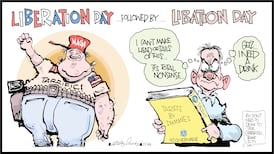Owen Keegan recently retired from heading up Dublin City Council. “All dictatorships must come to an end, even benevolent ones,” Fine Gael councillor James Geoghegan said at last week’s council meeting. “I don’t think we’ve agreed on a single issue,” Cllr Cieran Perry said. Councillor John Lyons said Keegan “maintained a very dysfunctional system,” which “wasn’t something that should be commended; it should be condemned”.
While Keegan’s departure date as chief executive was known for some time, even the task of hiring a new boss is being approached in dysfunctional fashion. The city will have an interim chief executive for months, Keegan’s deputy, Richard Shakespeare – a temporary approach that doesn’t speak to the cultural change required.
This cultural change is vital. Dublin needs leadership with a new value system that restores the city’s integrity. We are in a doom-loop media cycle about the state of the city, with hyperbolic and classist commentary focusing on crime.
Experiences of crime are not invented. Anyone who has been verbally abused, physically assaulted, intimidated, had their business robbed, who witnesses unchecked drug-dealing – particularly crack-dealing, for which there seems to be neither a cohesive policing strategy, nor the necessary resourcing across health and addiction services to adequately support people in the doldrums of chaotic addiction – should not have their experiences minimised.
Michael Lowry gave two fingers to the public. Their message back to the Government is equally concise
Authoritarian America is rewarding sameness and punishing difference
Ireland can make the world a better place. But first it must look in the mirror
From Paul Mescal to Bad Sisters to Claire Keegan, the green wave keeps rolling
Yet the lens of crime offers a blurry focus. It represents an attempt to capture a broader concern that there is something wrong with the capital, but falls short of correctly identifying the malady. The issue is the urban ecosystem has been broken. It has been made threadbare in multiple ways, and the outcome is a sort of depressed dysfunction generating a feeling and experience of a city losing a battle with blandness.
What has occurred, in part due to poor planning and destructive corporate gentrification, is a degradation of the urban habitat. The housing and amenity needs of working class communities that give Dublin city a great deal of its vitality are largely ignored. These communities are contending with the clutter of unwanted development breaking the intangible flow and functionality of urban life.
Add to this the pricing-out and ignoring of the needs of young people, artists and students who contribute to urban culture. Throw in an awful housing crisis. Add a council that views the city centre as a commercial district, happily closing down entire areas for visiting American college football fans, yet dawdling on basic aspects of residents’ needs – and you have a sense of flatness, not vibrancy.
The great Jane Jacobs wrote: “Cities have the capability of providing something for everybody, only because, and only when, they are created by everybody.” In her assessment of how city streets can be equipped to handle a diversity of people, making safety an asset, Jacobs identified various qualities. One is a clear demarcation between public space and private space: “public and private spaces cannot ooze into each other as they do typically in suburban settings or in projects.” This oozing is everywhere in Dublin, because where housing was built, the focus was on constructing isolated blocks of “developments”, and not on the creation and improvement of streetscapes where housing is embedded. The faux “shared” space that exists between blocks tends to be desolate. Where there could be communities, “units” lead to an atomised ambience.
[ Jane Jacobs, a visionary who changed how we think about citiesOpens in new window ]
Another desirable quality is “eyes upon the street”. When people live on a street, a sense of ownership and self-policing occurs. We know what this quality feels like when we walk down a street where housing is embedded. It feels lived in, somewhere people are going about their lives, engaged with the immediate environment, and where businesses are run by – and serving the needs of – those who live there, from long-existing communities to immigrant ones. This vibe and context exist only in parts of the city, and where it does, it’s great.
Another is the level of activity on paths: “the sidewalk must have users on it fairly continuously, both to add to the number of effective eyes on the street and to induce the people in buildings along the street to watch the sidewalks in sufficient numbers,” Jacobs wrote. “Nobody enjoys sitting on a stoop or looking out a window at an empty street. Almost nobody does such a thing. Large numbers of people entertain themselves, off and on, by watching street activity.”
Where quality dense housing that enhances community cohesion exists; where there are local businesses with a diverse offering; where people feel connected to each other and to the space; where streets are busy, areas thrive. There are fantastic things happening in Dublin in culture, community work, and hospitality. And yet so often, the people making things happen talk about the pressure of living in an expensive, under-resourced place.
As Dublin City Council enters a new era, the focus should be on community and culture. The council is not a tourist board, nor the IDA. Beginning with community and culture – and including local commerce – an ecosystem can be created that is inevitably attractive to tourists, business and people who move here. That neither council nor Government shouted stop as parts of Dublin’s character were erased isn’t just about profit, it’s a failure to appreciate the very tenets of good urbanism. It’s about an ideological framework that knows the price of everything and the value – aesthetic, social, cultural – of nothing. This value system needs to change, and more gardaí on the street will not achieve that.















